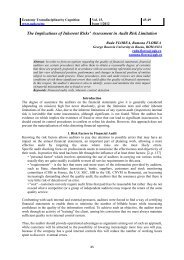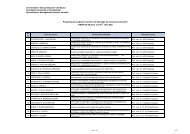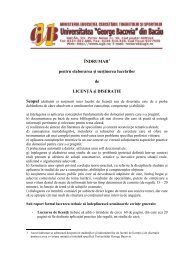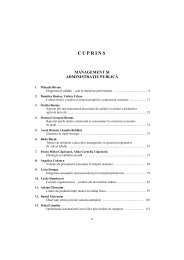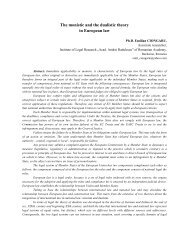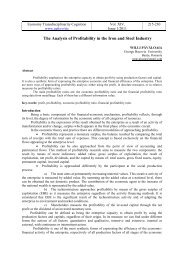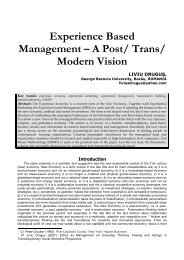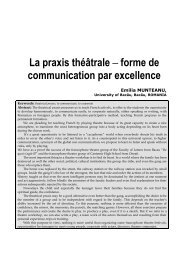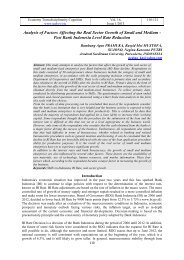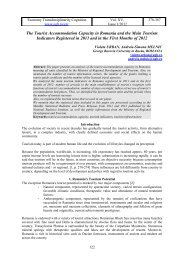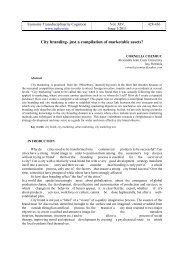BULETIN ÄTIIN IFIC - Universitatea George Bacovia
BULETIN ÄTIIN IFIC - Universitatea George Bacovia
BULETIN ÄTIIN IFIC - Universitatea George Bacovia
You also want an ePaper? Increase the reach of your titles
YUMPU automatically turns print PDFs into web optimized ePapers that Google loves.
36<br />
Liviu DRUGU, Toader GHERASIM, Camelia Mihaela CMECIU<br />
thinking and from modern logic to postmodern logic. Of course, this curriculum may be<br />
improved, changed, completed or simply applied to. The authors’ opinion is that “there are<br />
no real standards in developing transdisciplinary studies. There are only means, concepts<br />
and a transdisciplinary vision” (ibidem.).<br />
c. Thomas J.P. Thijssen and Wim Gijselaers from Prima Vera Research Group,<br />
University of Amsterdam published an article entitled Dynamics in Business and its<br />
Consequences for Learning Business. Learning by Sharing as a Model for Revitalization.<br />
Although the authors do not use the word transdisciplinarity, they give a direct<br />
answer to Basarab Nicolescu’s notice that universities do not share information. They<br />
made a plea for creativity, innovation and learning by sharing. We do believe that this is a<br />
postmodern and transdisciplinary thinking.<br />
The authors underline the idea that “researchers, teachers and students” are required<br />
to engage with practitioners in specific business contexts and need to develop a common<br />
language, test their mental models, learn from each other, create fresh knowledge and<br />
develop new learning practices to create academic and business value”. (idem., pp. 18-19)<br />
<br />
<br />
<br />
d. The authors of this article are promoting the transdisciplinary model of<br />
thinking, called EMMY, which has been already described in Chapter I. We make here a<br />
proposal of interconnecting all the above mentioned models and theories in a kind of<br />
alternative to modern and disciplinary thinking. More concrete, this way of interconnecting<br />
should be performed by sharing all these views to all structures interested in reforming<br />
education. So, instead of promoting individual visions (such as EMMY – Liviu Drugus,<br />
learning by sharing – Thomas J.P. Thijssen, the transdisciplinary school – Mircea Bertea et<br />
al., the transdisciplinarity PhD – Basarab Nicolescu ) we do propose to reciprocally know,<br />
criticize/comment and interfere for a common and stronger one. There is a real chance for<br />
education reformers to receive and interfere with all these models in order to create the<br />
transmodern universities, based on transdisciplinary thinking, following a real<br />
transdevelopment in a general and global transformation economy. In the following chapters<br />
we will try to define the components of such reformative measures. One of these is<br />
promoting a better communication between theoretical analysis and social economic reality,<br />
and generally speaking, using communication tools in the very complex and global process<br />
for bridging the gap between the social needs and the university offer/supply to meet them.<br />
<br />
$ ! %<br />
<br />
<br />
Unless there is communication between the social actors who act within this triadic<br />
structure of reality (education – transdisciplinary education, education policy –<br />
transdevelopment and business – transformation economy), every of the three<br />
components will be weak and this weakness will generate negative consequences to the<br />
other two. The process of transmitting this lack of strength could be explained in terms of<br />
coding and decoding information, which is, actually, a part of Umberto Eco’s definition of<br />
semiotics (theory of codes 9 = the semiotics of signification and the theory of sign<br />
production = the semiotics of communication).<br />
9 Daniel Chandler (2002: 147 - 150) defines codes as “a set of practices familiar to users of the medium<br />
operating within a broad cultural framework”. Codes organize signs (“something that stands for something<br />
else, to someone in some capacity” – Ch. S. Peirce) into meaningful systems which correlate a referent to<br />
signifiers (F. de Saussure)/ representamen (Ch. S. Peirce) and signifieds (concept)/ interpretant (Ch. S.<br />
Peirce).



